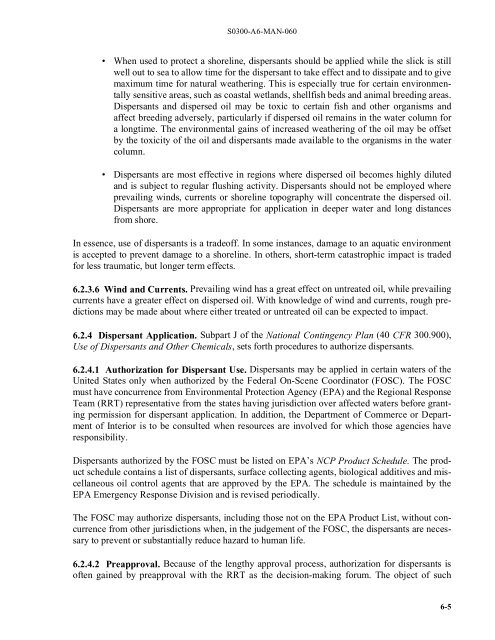U.S. Navy Ship Salvage Manual Volume 6 - Oil Spill Response
U.S. Navy Ship Salvage Manual Volume 6 - Oil Spill Response
U.S. Navy Ship Salvage Manual Volume 6 - Oil Spill Response
- No tags were found...
You also want an ePaper? Increase the reach of your titles
YUMPU automatically turns print PDFs into web optimized ePapers that Google loves.
S0300-A6-MAN-060• When used to protect a shoreline, dispersants should be applied while the slick is stillwell out to sea to allow time for the dispersant to take effect and to dissipate and to givemaximum time for natural weathering. This is especially true for certain environmentallysensitive areas, such as coastal wetlands, shellfish beds and animal breeding areas.Dispersants and dispersed oil may be toxic to certain fish and other organisms andaffect breeding adversely, particularly if dispersed oil remains in the water column fora longtime. The environmental gains of increased weathering of the oil may be offsetby the toxicity of the oil and dispersants made available to the organisms in the watercolumn.• Dispersants are most effective in regions where dispersed oil becomes highly dilutedand is subject to regular flushing activity. Dispersants should not be employed whereprevailing winds, currents or shoreline topography will concentrate the dispersed oil.Dispersants are more appropriate for application in deeper water and long distancesfrom shore.In essence, use of dispersants is a tradeoff. In some instances, damage to an aquatic environmentis accepted to prevent damage to a shoreline. In others, short-term catastrophic impact is tradedfor less traumatic, but longer term effects.6.2.3.6 Wind and Currents. Prevailing wind has a great effect on untreated oil, while prevailingcurrents have a greater effect on dispersed oil. With knowledge of wind and currents, rough predictionsmay be made about where either treated or untreated oil can be expected to impact.6.2.4 Dispersant Application. Subpart J of the National Contingency Plan (40 CFR 300.900),Use of Dispersants and Other Chemicals, sets forth procedures to authorize dispersants.6.2.4.1 Authorization for Dispersant Use. Dispersants may be applied in certain waters of theUnited States only when authorized by the Federal On-Scene Coordinator (FOSC). The FOSCmust have concurrence from Environmental Protection Agency (EPA) and the Regional <strong>Response</strong>Team (RRT) representative from the states having jurisdiction over affected waters before grantingpermission for dispersant application. In addition, the Department of Commerce or Departmentof Interior is to be consulted when resources are involved for which those agencies haveresponsibility.Dispersants authorized by the FOSC must be listed on EPA’s NCP Product Schedule. The productschedule contains a list of dispersants, surface collecting agents, biological additives and miscellaneousoil control agents that are approved by the EPA. The schedule is maintained by theEPA Emergency <strong>Response</strong> Division and is revised periodically.The FOSC may authorize dispersants, including those not on the EPA Product List, without concurrencefrom other jurisdictions when, in the judgement of the FOSC, the dispersants are necessaryto prevent or substantially reduce hazard to human life.6.2.4.2 Preapproval. Because of the lengthy approval process, authorization for dispersants isoften gained by preapproval with the RRT as the decision-making forum. The object of such6-5
















